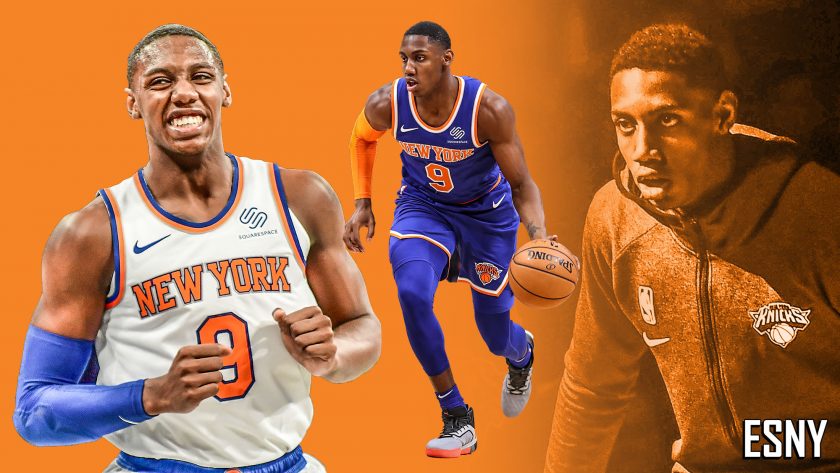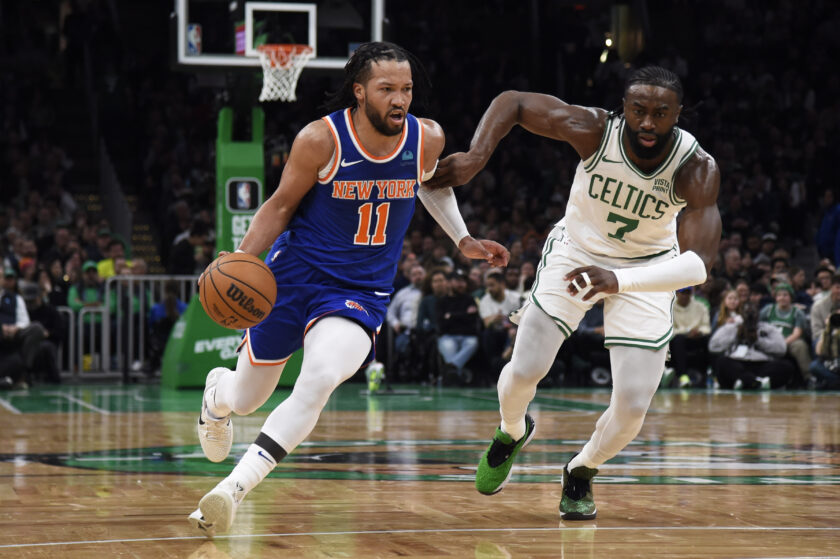New York Knicks Film Room: Evaluating RJ Barrett’s rookie season

New York Knicks rookie RJ Barrett has experienced his share of ups and downs this season. Despite his mixed production, the best is yet to come.
[sc name=”geoffrey-campbell-banner” ]The New York Knicks have big plans for RJ Barrett. Selected with the third overall pick in the 2019 NBA Draft, Barrett represents the orange and blue’s highest draft selection since Patrick Ewing was taken first overall in 1985.
The development of Barrett, along with Mitchell Robinson, represents the Knicks’ greatest chance at becoming a relevant basketball team. Even though Barrett’s draft position may carry with it the expectations of a future star, Knicks’ fans need to be patient and enjoy the gradual improvement of a smart and hard-working player.
As a 19-year old wing, Barrett’s talent may not always make SportsCenter’s Top 10 plays, but that doesn’t make him any less impressive. The former Duke freshman has an offensive game that meshes the spirit of a construction worker who clocks in every morning with Fred Astaire. Despite his obvious talent, Barrett has no problem with putting in the work for his points.
Back in June, I wrote a scouting report on Barrett and outlined his strengths, weaknesses and potential fit with the Knicks. Fast forward to January and some questions have been answered. Barrett still struggles with shooting the ball from the field and from the free-throw line and his development both areas will likely be the primary indicator of his ceiling as a player.
However, putting aside his ability to finish at the rim and score in traffic, Barrett’s defense (in spurts) and decision-making with the ball in his hands have been some of the more impressive parts of his game.
Let’s take a look at the total sum of Barrett’s first 41 games in the NBA from the offensive and defensive sides of the ball.
Offense
Coming out of college, Barrett ranked ninth in the NCAA in attempts at the rim and fourth in field goal percentage. At the pro level, Barrett has found it much tougher to convert. Per Synergy Sports, he converts drives to the basket off the pick and roll within the 13th percentile. Despite Barrett’s size and strength, he’s still finding it difficult to navigate amongst the massive Joshua tree-like forwards and centers in the paint.
Playing 31 minutes per game and putting up 13 shots a night, Barrett has certainly been given the leeway, and rightfully so, to work through his mistakes going up against some of the best athletes in the world. Even though the percentages don’t scream efficiency, New Yorkers love the way that Barrett works for his points and it comes through when you watch his tape.
In the first clip, you’ll see Barrett post-up Tyler Herro and manipulate the defense with his dribble to avoid the double-team. Barrett eventually gets into the middle and finishes through contact. The second clip features Barrett using his size and strength to put up an off-balanced shot off the glass with his off-hand.
Despite the level of difficulty, Knicks fans have become accustomed to seeing this type of shot from their rookie. Furthermore, it’s been encouraging to see him finish with the right hand more often than he did in college.
Similar to Barrett’s efficiency at the rim, his shooting percentages have been poor. Shooting 39 percent from the field and 60 percent from the free-throw line, Barrett won’t be an analytics darling anytime soon, but at the end of the day he is 19 and there is plenty of room for growth. Fortunately for Barrett, his shooting form is not broken, he’s just not always consistent in that area.
For me, the shot that Barrett appears to be most comfortable with is the step-back mid-range jumper or the pull-up jumper around the foul-line. The numbers don’t support it, well…because none of his shooting numbers look good, but this is where Barrett’s form seems to be the fluid and effortless, or at least it’s shot where he’s not thinking so much. Both of the following clips show how clean Barrett’s shot can look when he gets his legs under his shot and follows through with his shooting hand.
Putting these clips aside, there’s been a lot of brick-laying from Barrett this season. But in January, there has been a positive trend. Barrett has shot 35 percent from the three-point line and 74 percent from the line. He is also getting to the line more with just over five free throw attempts per game. In a recent blow-out loss to the Milwaukee Bucks, Barrett even hit five of seven threes and poured in 22 points to go along with eight rebounds.
But if you’re still down on Barrett’s potential because of his shooting, you have to be, at least, mildly impressed with his decision-making as a playmaker. Coming out of college, Barrett and the words “tunnel-vision” were often associated with each other. Watching his games it was easy to get frustrated with his tendency to drive into multiple defenders and launch contested shots when an easy pass was available.
At the pro level, Barrett has proved that he can make advanced reads in the pick-and-roll, plus he’s also shown some impressive awareness for passing near the rim in tight spaces. The first two clips show Barrett freezing defenders just enough to hit open shooters at the three-point line. The final clip is just silly. Barrett makes everyone think that he’s going to the rack and somehow, with eyes in the back of his head, finds Taj Gibson cutting to the rim. Degree of difficulty = Expert.
Barrett can improve in just about every area from an offensive perspective. But his court awareness and patience, as a 19-year old, should make fans rest easy when they think about what he can be. I’m not sure he’s a perennial All-Star, but I’m certain he will impact the game and make winning plays for his team for a long time.
Defense
Barrett’s off-court net rating is a -6.4 compared to his on-court net rating which is a -8.7. Defensively, there’s an even bigger discrepancy as the Knicks post a 113.6 defensive rating when Barrett is on the court, as opposed to a 108.0 rating when he’s off the court.
But on a team with just 12 wins, I would not make wholesale judgments based on those numbers. Any NBA rookie will struggle with defense and Barrett is no different, but this is another area where I’ve seen, at the very least, a consistent effort and some flashes of good defense.
Some statistics support the idea that Barrett is improving as a defender. Per Synergy Sports, Barrett ranks within the 76th percentile in guarding the pick-and-roll ball handler and within the 77th percentile in guarding opposing players coming off screens. Yet’s Barrett’s ability to guard in isolation ranks only within the 40th percentile.
Additionally, Barrett currently ranks 4th among rookies in steals per game and 2nd in total steals with 43 on the season. Looking at the tape you can see that Barrett has good defensive instincts.
In the first clip, Barrett takes the hit off a DeAndre Jordan pick, fights through it, and hustle to intercept Garrett Temple’s pass. The second clip shows Barrett stealing a back-door pass and the third clip showcases Barrett’s anticipation as he steals a pass intended for Lonzo Ball and heads up for the floor for an easy two points.
Barrett’s rebounding, at the guard position, has also been a positive note this season. Barrett currently ranks fifth among rookies in rebounds per game and every player ahead of him is a forward. At Duke, the Consensus All-American averaged just over seven boards per game and it’s clear that when he grabs rebounds he’s looking to push the pace immediately.
In the first clip, Barrett beats four Milwaukee Bucks, including Giannis Antetokounmpo for the rebound, tapping it to himself, keeping the possession alive. The second clip features a solid box-out where Barrett uses his strength to hold off Patrick Patterson who boasts a three-inch height advantage and almost 30 pounds in weight.
The third clip shows Barrett going toe-to-toe with Montrezl Harrell, coming up with the rebound to start the break.
As it stands, Barrett’s overall defensive portfolio still needs improvement and that is to be expected. However, Barrett has a good enough understanding of the Knicks defensive coverages, and his effort is generally consistent. Barrett also uses his size and strength well which will be even more important as he continues to grow into his body.
Conclusion
Overall, if you just look at the stats, Barrett’s first half of his rookie season doesn’t inspire a lot of excitement. He’s been a fairly high usage player with not a lot of efficiency. Even though I think his shooting will improve, it’s reasonable to be concerned when your star rookie’s field goal percentage and free-throw percentage have decreased since college.
But if you’re looking for the silver lining, Blake Griffin also struggled with his shooting during the early parts of his career and improved. Griffin eventually improved his free-throw shooting from 52 percent during his second year in the league to a career-high 78 percent during the 2017-2018 season.
DeMar DeRozan, a player who is often compared with Barrett, as a 20-year old, shot 25 percent from the three-point line during his rookie season. And while no one will confuse DeRozan with a JJ Redick anytime soon, DeRozan has had a productive career, yes as a volume mid-range scorer, but still effective in the modern NBA.
As I mentioned before, I’m not sure that I see Barrett becoming a perennial All-Star. He may not have the talent of his fellow draft class selections such as Ja Morant or Zion Williamson, but Barrett’s basketball I.Q. is definitely ahead of his 19-year-old body. Furthermore, it’s Barrett’s worth ethic and approach that excites me the most and it’s caught the eye of Knicks head coach Mike Miller.
Per Ian Begley of SNY, Miller explains,
“It stands out. I think he’s unique. That’s one of his skills,” Miller said of the 19-year-old Barrett. “It’s things that can be taught and learned with experience but he walks in as a young guy and he has that. You have to give him credit and the people that have worked with him and how he has developed that at a young age.”
He goes on to talk about Barrett’s resiliency…
“We saw that in Summer League. He was the first one ready to come right back in and want to play the next day. It didn’t matter how it went the day before,” Miller said of Barrett’s Summer League, which started with some subpar outings. “He plays that way from one play to the next, from one quarter to the next quarter, from one half to the next half. It’s a good thing.”
In the end, I think Barrett projects to be a productive player that impacts winning. His offensive efficiency and defensive production will take time to develop but he already embodies the city’s spirit of a blue-collar, hard-working player with a desire to be better.
In New York, if you have at least that, the fans will be patient for the rest to come.





